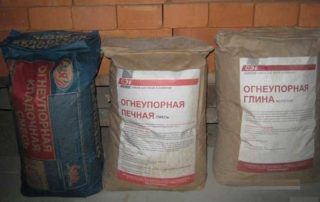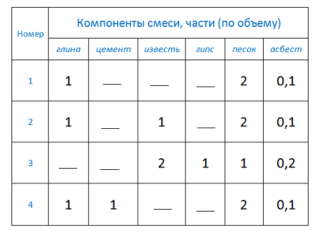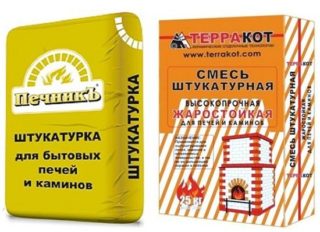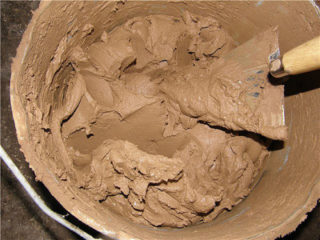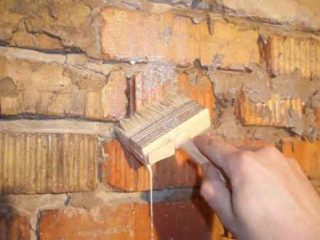Fire-resistant finishing mixtures are durable and do not deform under the influence of high temperature. Cracks worsen the appearance of the hearth and pass carbon monoxide into the room, therefore, heat-resistant putty for stoves is used. The composition is bought ready-made or prepared according to the technology with his own hands using heat-resistant materials.
The composition of materials and mixtures for the furnace
The walls of the stove heat up during operation, so the usual mixture will crack and crumble in a few months. The raw materials for mixing the refractory putty for the furnace are sand, cement, gypsum, lime and clay.
Recommendations for the preparation of the solution:
- it is preferable to use lime or clay in the composition, but asbestos must be added;
- complex cement-based mixtures can be used, but asbestos or other fibers remain an additional component;
- straw or hemp can replace asbestos.
Store dry putties are closed with water in accordance with the instructions on the packaging. Ready mixes in buckets are pre-mixed. The amount of solution that is used before hardening and loss of ductility is prepared.
A composition is prepared on its own to coat small foci; for large furnaces, it is better to purchase high-temperature mixtures prepared at the factory.
Materials
Sand is a sedimentary rock of a loose structure, consisting almost entirely of silicon dioxide. For the solution, river, marine and quarry species can be used. The grains of sand formed in water bodies are rounded with a smooth surface.
Clay is a sedimentary rock, including kaolinite, in the dry state it represents dust, it becomes plastic when moisture is added. Porous and waterproofing material is characterized by sintering, fire resistance, viscosity, and shrinkage.
Lime is obtained by artificially calcining carbonate rocks and includes a large amount of calcium, magnesium, dolomite. Lime dough or slaked variety (kipelka) is used.
Mineral filaments from the group of silicates, which in nature form flexible fibers, are called asbestos. It belongs to carcinogens, has high heat resistance, does not dissolve, but fluffs in water. In the putty for the furnace serves as a binder and dispersed component.
Cement refers to cement binders inorganic substances obtained by artificial means. When moistened, forms a plastic mixture, which subsequently hardens and gains strength not only in air but also in water.
Refractory mixtures
Factory refractory compounds are versatile and are intended for high quality work. Manufacturers abandoned the use of asbestos due to a carcinogenic effect and replaced it with harmless components.
Common finished formulations:
- Plitonite. The line of Russian-German manufacturers includes Super-Fireplace brand materials for domestic and industrial centers. Scope varies with composition.
- Mastic Titan. The solution is prepared on the basis of stone flour with polymer additives. Heat-resistant putty for the furnace adheres firmly to the surface and withstands up to + 1300 ° С.
- Terracotta. Gray plaster quickly sets, breaks down at + 400 ° C, can be applied with a layer of up to 8 mm.It is prepared on the basis of kaolin clay fireclay.
- Thermo +999 brand PRO. The composition is suitable for top application and for repairing the fuel compartment. The reinforced solution withstands + 1000 ° С, sets in 1 hour, but fully gains strength during the day.
Coating for stoves and fireplaces Emelya is made on the basis of white heat-resistant clay and kaolin. The dry mixture is diluted with water, after hardening it prevents cracks and shedding of the layer.
The Pechnik trademark is a competitor of the famous Terracott brand, withstands surface heating up to + 300 ° C, is applied with a layer of up to 10 mm. The lineup has starting and finishing mixes.
Advantages and disadvantages
Heat-resistant putties have advantages over traditional solutions. They are characterized by high strength under high temperatures due to the presence of binder fibers and the use of refractory materials.
Positive points of application:
- The solution consists of safe components; when heated, harmful airborne contaminants are not released.
- The putty prepared in compliance with the technology and application rules serves for a long time.
- Mixtures stick well to the surface of the stove, made of various materials, there are varieties that are used for finishing on metal.
The disadvantages include a higher cost than standard finished mixtures. Such compositions are rarely used as a top coat - they need to be painted or tiled.
Self-preparation of putty for the oven
A solution prepared by hand saves money and differs little from factory mixtures. For cooking, natural materials are used, which are in all areas.
The compositions are being prepared:
- gypsum-sand-limestone (0.3: 2: 2);
- clay-sand-limestone (1: 2: 2);
- clay-sand-cement (1: 2: 0.3).
If the clay is skinny, the solution is sealed in skim milk. The addition of slaked lime lightens the putty, finally a white color is given by a mixture of chalk and milk. Fiber in the amount of 1/10 of the total volume is added to the mass. Gypsum additives accelerate the hardening, so you need to knead less solution.
You will need chamotte or other oily clay, sand, lime, gypsum (alabaster). The volume of sand depends on the fat content of the main component, but for the first time it is difficult to determine the desired proportions. The advice of an experienced professional will help.
Intended use of the mortar
The surface treatment of the stove improves the appearance and helps the hearth to fit into the interior. Regardless of the material of the structure, putty levels the surface. It is important to strengthen the strength of the walls on which the plaster remains for a long time in its original form.
If the masonry cracks, combustion products pass through the cracks and lead to carbon monoxide poisoning. Conventional putties do not withstand high temperatures, are destroyed and contribute to the formation of cracks. The uneven surface of the masonry accumulates dust, soot and is poorly cleaned from contamination. A layer of putty is stained with heat-resistant paints.
The technology of finishing furnaces with stucco
For work, standard tools are used. Surface preparation is required for a good fit. The thickness of the plaster is determined before the start of the process using the level, plumb line and straight rail.
Work order:
- Remove old and peeled coatings, if any. Used a brush for metal work or a hammer and chisel. Cleaning is carried out before initial laying.
- Notches are made and the seams deepen by about 0.7 cm.
- The surface is primed with a deep penetration composition. The degree of adhesion depends on this.
- A reinforcing mesh of metal is nailed. Used nails or screws with dowels.
- The spray is done in the first layer and almost does not level out. The second layer is applied to determine the texture on the cultivated area.
The surface is smoothed with a trowel with the addition of a certain amount of solution in the pits. The mixture should dry completely and set before finishing decoration.
Decorative finish
The topcoat is selected depending on the preferences of the owner and the surrounding interior. Puttying the gypsum stove for painting is carried out with mixtures that can withstand high temperatures.
The hearth in the room gets off:
- improved putty with painting;
- decorative plaster;
- natural stone, marble;
- artificial material under the stone;
- metal, heat resistant glass;
- ceramic tiles, granite;
- decorative brick (bassoon).
For any type, materials with refractory properties are used. Natural stone does not crack when heated, but the quality of the glue matters. Ceramics can withstand temperature changes, but tiles are laid with seams, a seamless method is not applied. Crosses are used for tiles to withstand the same intervals.
